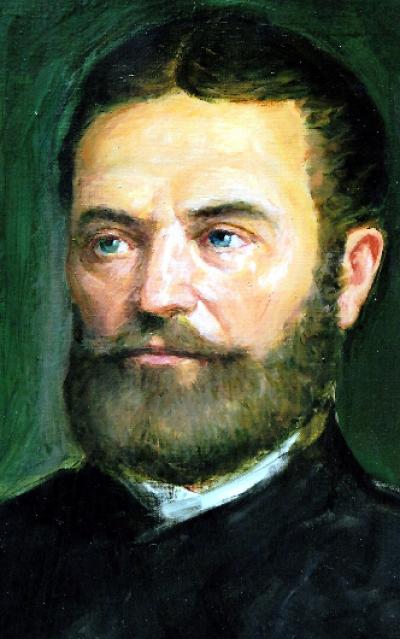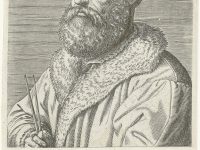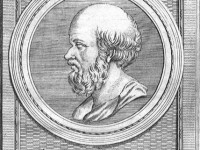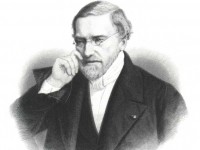On December 15, 1802, Hungarian mathematician János Bolyai was born. He is most famous for being one of the founders of non-euclidian geometry, a geometry that differs from Euclidean geometry in its definition of parallel lines.
János Bolyai – Background
Bolyai was born in the Transylvanian town of Kolozsvár (Klausenburg), then part of the Habsburg Empire (now Cluj-Napoca in Romania), the son of Zsuzsanna Benkő and the well-known mathematician Farkas Bolyai. Farkas Bolyai always wanted his son to be a mathematician, and he brought him up with this in mind. But, János’s education was not put first in the Bolyai household as you might think. Instead Farkas believed that a sound mind could only achieve great things if it was in a sound healthy body, so in his early years most attention was paid to János’s physical development.
Until János was nine years old the best students from the Marosvásárhely College taught him all the usual school subjects except mathematics, which he was then taught by his father. Only from the age of nine did he attend school. By the time Bolyai was 13, he had mastered the calculus and other forms of analytical mechanics, his father continuing to give him instruction.[1] He also became an accomplished violinist at an early age and later was renowned as a superb swordsman. He studied at the Royal Engineering College in Vienna (1818–22) and served in the army engineering corps (1822–33).
The Parallel Postulate
Like his father, János became so obsessed with finding a proof for Euclid‘s fifth postulate [11] (often referred to as the parallel postulate) that his father wrote to him:
“For God’s sake, I beseech you, give it up. Fear it no less than sensual passions because it too may take all your time and deprive you of your health, peace of mind and happiness in life“.
Euclid’s parallel postulate has been a fundamental principle of geometry for over two millennia, which essentially states that only one line can be drawn through a given point so that the line is parallel to a given line that does not contain the point, along with its corollary that the interior angles of a triangle sum to 180° or two right angles.[3] János, however, persisted in his quest and eventually came to the conclusion that the postulate cannot by proven and must be independent of the other axioms of geometry and that different consistent geometries can be constructed on its negation.
“I Created a New World out of Nothing”
In reply, he wrote to his father: “I created a new, different world out of nothing.” Between 1820 and 1823 he prepared a treatise on a complete system of non-Euclidean geometry, which was published in 1832 as an appendix to a mathematics textbook by his father as “Appendix Scientiam Spatii Absolute Veram Exhibens” (“Appendix Explaining the Absolutely True Science of Space”.[2] Bolyai explored what he called “imaginary geometry” (now known as hyperbolic geometry), the geometry of curved spaces on a saddle-shaped plane, where the angles of a triangle did NOT add up to 180° and apparently parallel lines were NOT actually parallel.[3]
![Hyperbolic Bolyai-Lobachevskian geometry [3]](http://scihi.org/wp-content/uploads/2014/12/bolyai_hyperbolic.gif)
Hyperbolic Bolyai-Lobachevskian geometry [3]
Gauss and Lobachevsky
A copy of this work was sent to Carl Friedrich Gauss in Germany, who replied that he had discovered the main results some years before.[10] This was a profound blow to Bolyai, even though Gauss had no claim to priority since he had never published his findings. Gauss, on reading the Appendix, wrote to a friend saying “I regard this young geometer Bolyai as a genius of the first order“. In 1848 Bolyai discovered that Nikolay Ivanovich Lobachevsky had published an account of virtually the same geometry already in 1829.[9] Though Lobachevsky published his work a few years earlier than Bolyai, it contained only hyperbolic geometry. Bolyai and Lobachevsky did not know each other or each other’s works.
Further Achievements
In addition to his work in geometry, Bolyai developed a rigorous geometric concept of complex numbers as ordered pairs of real numbers. Although he never published more than the 24 pages of the Appendix, he left more than 20,000 pages of mathematical manuscripts when he died in poverty and obscurity, nearly blind and unable to walking, in 1860.
Martin Mathieu MRIA, Hamilton Lecture 2021: Glimpses into Hyperbolic geometry, [13]
References and Further Reading:
- [1] O’Connor, John J.; Robertson, Edmund F., “János Bolyai“, MacTutor History of Mathematics archive, University of St Andrews.
- [2] János Bolyai at Encyclpopedia Britannica
- [3] Bolyai and Lobachevsky – The Story of Mathematics
- [4] János Bolyai at Wikidata
- [5] János Bolyai at zbMATH
- [6] János Bolyai at Mathematics Genealogy Project
- [7] Eugenio Beltramy and Non-Euclidian Geometry, SciHi Blog
- [8] Gaspar Monge and the Geometry, SciHi Blog
- [9] Nikolai Lobachevsky – The Copernicus of Geometry, SciHi Blog
- [10] Carl Friedrich Gauss – The Prince of Mathematicians, SciHi Blog
- [11] Euclid of Alexandria – the Father of Geometry, SciHi Blog
- [12] János Bolyai at Wikidata
- [13] Martin Mathieu MRIA, Hamilton Lecture 2021: Glimpses into Hyperbolic geometry, The Royal Irish Academy @ youtube
- [14] Janos Bolyai, “The Science Absolute of Space: Independent of the Truth or Falsity of Euclid’s Axiom XI (Which Can Never Be Decided A Priori)”, The Neomon, Austin, 1896.
- [15] Marvin Greenberg (1994) Euclidean and Non-Euclidean Geometries: Development and History, 3rd edition, W. H. Freeman
- [16] Timeline of 19th century mathematicians via Wikidata and DBpedia






